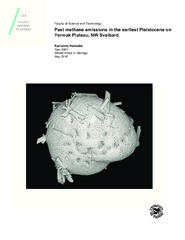Past methane emissions in the earliest Pleistocene on Yermak Plateau, NW Svalbard.
Permanent link
https://hdl.handle.net/10037/10185Date
2016-05-15Type
Master thesisMastergradsoppgave
Author
Heimdal, KarianneAbstract
Hole 912A (Ocean Drilling Program (ODP) Leg 151) drilled on the Yermak Plateau (eastern Arctic Ocean) is used to investigate past methane emissions in the earliest Pleistocene. Preliminary work showed depleted δ¹³C values at 93-96 meters below sea floor (mbsf), and an increase in methane concentration between 11, 5 and 23 mbsf. A secondary sampling focused on intervals between 10 and 23 mbsf (core 912A-2H and 912A-3H) and between 78 and 116,6 mbsf (core 912A-10X, 912A-11X and 912A-13X). The results are divided into intervals, where several intervals show depleted δ¹³C values in foraminifera test. Depleted calcite δ¹³C values in interval II from 13,05 to 20,18 mbsf could imply an early effect of diagenesis due to a suggested modern day sulfate-methane transition zone (SMTZ) located between 13 to 23 mbsf. Extremely negative calcite δ¹³C values in sediments represented in interval III and IV (71,96 to 97 mbsf) have been interpreted as being due to secondary methane-derived authigenic carbonates. This clearly indicates that the benthic foraminifera record past methane seepage events on the Yermak Plateau. The result is consistent with other studies that attribute anomalous carbon isotopic depletions in marine sediments to release of methane from destabilized methane hydrates. The mechanism for gas hydrate dissociation is suggested to be associated with an ice shelf retreat after ~1.5 Ma (millions of years before present) of the Svalbard-Barents ice sheet, and temperature changes due to increased inflow of warmer water currents through the Fram Strait.
Publisher
UiT Norges arktiske universitetUiT The Arctic University of Norway
Metadata
Show full item recordCollections
Copyright 2016 The Author(s)
The following license file are associated with this item:


 English
English norsk
norsk
